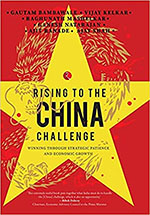Rising to the China Challenge is an engrossing compilation of essays by authors of eminence and provides a comprehensive coverage of the economic issues that underpin the growing disparity in Comprehensive National Power (CNP) between India and China. Starting with the Galwan incident in 2020, the book states that the existing paradigm between India and China, where geographical disputes were isolated from economic interaction, is no longer tenable. After a detailed analysis of the challenge faced from China, it goes on to propose a set of economic and diplomatic policy responses for India to redress this imbalance. The book is divided into six chapters, with a comprehensive Introduction, which serves as an executive brief for the book.
The book brings out that China’s economy is today five times the size of India’s for two main reasons—it commenced its economic reforms 13 years before India and also continued to grow at a much faster sustained rate. 40% of our trade deficit is with China, which has touched US$77 billion in 2021-22. What is more worrying is our total dependence on China in critical sectors such as pharmaceuticals, where we are a leading global exporter. The supply chain fragility in our trade with China requires safety measures in the form of alternate/indigenous sources. This disparity between our economies is the fundamental reason for our strategic weakness vis-à-vis China, which needs to be redressed. On the positive side, the book sees headwinds for China to grow at a sustained high rate in the decades ahead, and opines that India has an opportunity to narrow the gap. This is important because Xi’s centralization of power and aggressive leadership after taking over in 2013 clearly indicates that China is ‘no longer biding its time or rising peacefully’, and is instead now aiming for global hegemony. The book correctly highlights that the struggle with China is not merely an economic competition, but a larger conflict between two civilizations and the concepts of democracy and authoritarianism.

